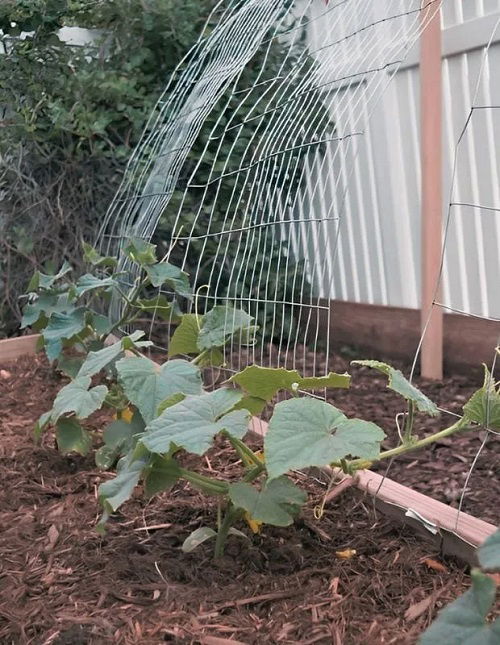Do you want to know the Secrets to Growing Cucumbers Like Seasoned Gardeners? If yes, read this article to get some valuable tips.

If you want the best cucumbers out there with a crunchy texture and juicy flesh, you need to go them a little differently. How? That’s where I come in with my bag of tips!
Secrets to Growing Cucumbers Like Seasoned Gardeners
Well, I can say that I have experimented a lot when it comes to growing vegetables in different ways. With cucumbers, it works the best if you will follow the secrets I have for you!
1. It All Starts with the Right Variety
Before you move ahead, understand that not every plant is suited for every zone, so it is important that you pick a variety that’s best suited according to the climatic conditions that you have in your area.
For example, if you live in a warm zone, then go for Marketmore 76, Diva, Armenian, Suyo Long, and Lemon Cucumber—it goes without saying that these varieties won’t grow well in colder zones.
Similarly, for cold climates, pick National Pickling, Little Leaf H-19, Salad Bush, Spacemaster 80, and Cool Breeze.
So, do a little research and pick the ones that suit your zone the best!
2. Bush, Heirloom, and Vining Cucumbers – Which One’s the Best?
Well, this is another area where people get confused, so let me clear this out for you.
- Bush cucumbers are great for people having a small space. These have a compact growth habit and reach a maximum of 2-3 feet in spread. ‘Salad Bush’ and ‘Bush Champion’ are two of the best examples.
- Heirloom Cucumbers are genetically modified and are open pollinated, the reason why they have a better taste and texture. These can be either bush or vining, so you can pick them according to the space you have. ‘Lemon Cucumber’ and ‘Armenian Cucumber’ are two popular varieties.
- Vining Cucumbers, like the name suggests, have a vining habit and require a support of a stake. They have a higher yeild and need more space to spread and grow. Marketmore 76′ and ‘Straight Eight’ are the popular ones.
3. When You Plant Them Plays a Vital Role
Once you are sorted with the variety, it is important that you grow them at the right time. You just can’t start cucumbers at any time of the year and expect them to flourish!
For warm USDA Zones (7-11), the best time to plant is late spring to early summer, which is from late March, or April through August.
For cold USDA Zones (3-6), wait until after the last frost date. Start growing them by late May to September.
Remember, cucumbers need plenty of light—a minimum of 6-7 hours of direct sun every day for their healthy growth
4. What’s the Soil Preparation?
I have seen many people growing cucumbers in plain garden soil. Well, I’m not saying it results in no fruits, but it will surely result in low-quality ones. For the best size and flavor, it is important you use the right mix.
In my years of experimenting, I have found what works with the cucumbers the best:
- 50% Coconut Coir
- 30% Compost
- 10% Perlite or Vermiculite
- Handful of Worm Castings or Bone Meal
Mix them well, and you will have the most nutritious and pocket-friendly growing medium for those tasty cucumbers! This works for both—pots and while preparing a raised bed.
If you are growing them in the garden, replace coconut coir with garden soil in the above mix.
5. The Right Watering Technique
People usually follow the water once in 3-4 days with cucumbers. Well, that’s not entirely wrong, but remember, we want to achieve what the others haven’t, right?
The key here is to water the plants deeply—this ensures the roots are properly wet and get the right moisture that provides that juicy texture to the fruits.
Follow this process, which can be anywhere between 1-3 times a week, depending on the sunlight and air circulation. Make sure the soil is always a little on the moist side all the time.
Remember that cucumbers hate wet leaves and that attracts fungal issues. Spraying the foliage with water will do more harm than good.
Pro Tip: Applying a thick layer of organic mulch around your cucumber plants can help retain soil moisture, regulate soil temperatures, and suppress weed growth. Use materials like straw, leaves, or grass clippings, spreading them around the plants to a depth of 2-4 inches.
6. How You Feed Them Sets the Course of Fruits for the Future
With cucumbers, it is not important which fertilizer you use to feed them. What matters is how you use it!
For starters, you can go with any balanced liquid blend. With me, 10-10-10 or 5-10-10, works the best.
Now comes the most important part—how to fertilize. For that, I will break the feeding cycle into three parts:
- Planting Stage: The initial yet the most important phase. When you see the plants growing to a height of 1-2 feet, feed the plant with a dose mentioned on the label.
- Vegetative Growth Phase: This is the time when you will see the plant vining in all direction—an indication that it is ready for the second application.
- Pre-Fruit Set Stage: Just when you see it form the buds, well, time to feed it! This will support the fruit development and will result in that juicy harvest!
Pro Tip: At the time of the seedling stage, put 3-4 granules of any granular fertilizer in the planting hole to give it a boost!
A Must Try: You can hand-pollinate the flowers at this stage to experiment!
7. You Gotta Support Them!

Well, in literal sense! The moment the plant gets full of cucumbers, the weight can be too overwhelming for the stems to bear and they will droop. All this will waste your precious cucumbers as they will touch the ground and rot.
A plastic or bamboo or A-shaped trellis will come to the rescue. Train the vines on them to distribute the weight, right from the early stages (when they are about a foot long) of the plant development.
Not only does it save space, but it also improves air circulation, thus preventing the fruits from resting on the ground (which can cause rot or misshapen cucumbers), and produces straighter, more uniform cucumbers.
8. Make Sure they Make Some Friends
Growing cucumbers alongside certain companion plants can be beneficial in various ways. Legumes like beans and peas can help fix nitrogen in the soil, while radishes can serve as a trap crop for pests like cucumber beetles.
Tomatoes and cucumbers are best buddies! Tomatoes keep cucumber beetles at bay, while cucumbers deter some tomato pests.
Nasturtiums are also great to plant with cucumbers as they release compounds that keep aphids away from cucumbers. They also attract beneficial insects in the garden.
9. Use the Magic Potion – Epsom Salt!
Epsom salt helps the nutrient uptake in cucumbers, meaning the plant will grow better, producing bigger and better fruits. All you have to do, is to use a tablespoon of it in a gallon of water and use it on the plant once in 6-8 weeks. We have a great article on it here.
Harvesting
Any fruit between 6 to 8 inches in length is good to pick. Look for the ones that have a bright, even green color. Yellowing is a sign of over-ripeness, which results in bitterness.
Remember, the key here is to regularly harvest the plant, once its starts producing fruits to increases the production. Check the vine every other day for fresh cucumbers. Also, do not pull them off the stem—use a cutter to make a clean cut.







